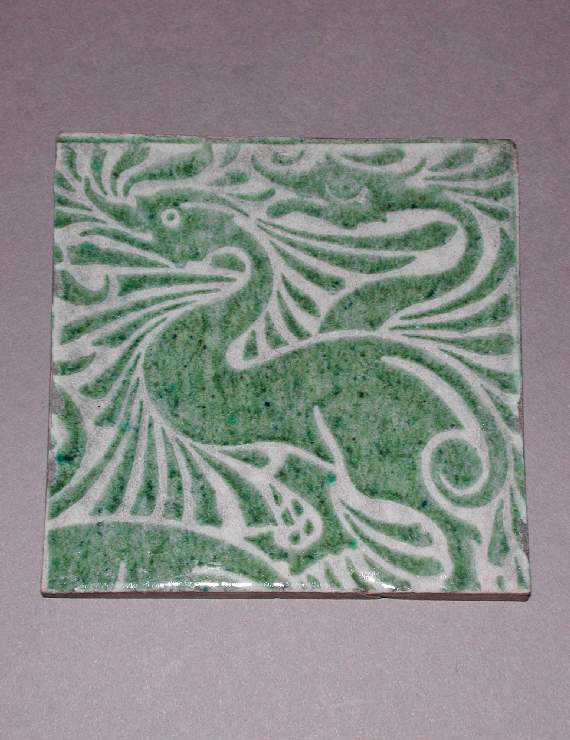Current Location: In storage
Titles
Tile with green duck design
Maker(s)
Maker:
William De Morgan & Co.
Designer:
De Morgan, William Frend
Entities
Categories
Description
Square earthenware tile, covered in white slip, decorated in green and glazed. The monochrome green, under-glaze design of a two-headed fantasy duck surrounded by stylised leaves has been applied by transfer, and covers the whole upper surface. At the top of the tile is a horizontal line, and at bottom left the back of another duck, as if the image has been cut from a larger design. The glaze is clear and crackled.The back and the sides are unglazed.
Notes
History note: Given by Mr H C Mossop
Legal notes
Given by Mr H C Mossop
Measurements and weight
Depth: 0.6 cm
Square: 7.6 cm
Square: 3 in
Acquisition and important dates
Method of acquisition: Given
(1941-03-26)
by
Mossop, H. C.
Dating
19th Century, Late
Victorian
1882
CE
-
1888
CE
Note
This tile has been produced using De Morgan’s invention of tracing and painting the design onto paper which burned away in the kiln, leaving the design fixed under the glaze. The design has been cut down from that used on another tile in the Fitzwilliam collection (EC.9-1941), the original of which held in the V&A collection (V. & A. E.952-1917, Box C.145). According to Jon Catleugh, the design dates from the period when De Morgan was based in Chelsea from 1872 to 1882. However, the mark indicates that this tile was produced later, when De Morgan’s workshop was at Merton Abbey (1882-88). The tile is unusually small – De Morgan usually worked on 6x6 inch blanks (or sometimes 4-12 ins. – see Gaunt), but the Fitzwilliam holds another, similarly coloured, three inch tile where the pattern has been cut down. Possibly these were test pieces or samples. De Morgan made many, many designs for tiles and tile panels – some 820 are in the V&A collection.
William Frend De Morgan (1839-1917), now widely regarded as the most important ceramicist of the Arts & Crafts movement, also worked in stained glass and became a successful novelist. The son of a non-conformist mathematics professor, he became a close friend of William Morris and Edward Burne-Jones and married the Pre-Raphaelite painter Evelyn Pickering (1855-1919), in 1887. As a ceramicist, De Morgan was primarily a designer/decorator and chemist, working on bought-in blanks or pots thrown to his design. He experimented widely with techniques and glazes, re-discovering methods for making and applying lustres and the colours of Iznik and Persian pottery and using them for a range of complex fantasy designs featuring ships, birds, flora and animals.
School or Style
Arts and Crafts (movement)
People, subjects and objects depicted
Components of the work
Decoration
composed of
transfers
( green)
clear glaze
Materials used in production
buff-coloured
Earthenware
Techniques used in production
Slip-coating
: Earthenware, slip-coated and decorated with a transfer design, glazed
Inscription or legends present
Inscription present: small, oval Merton Abbey seal
- Text: DE MORGAN / MERTON ABBEY
- Location: On back of tile
- Method of creation: Impressed
- Type: Mark
- Text: 1941 / 14
- Location: On back of tile
- Method of creation: Circular paper label handwritten in black ink
- Type: Label
References and bibliographic entries
Identification numbers
Accession number: EC.14-1941
Primary reference Number: 15378
Stable URI
Audit data
Created: Saturday 6 August 2011
Updated: Tuesday 30 April 2024
Last processed: Tuesday 13 May 2025
Associated departments & institutions
Owner or interested party:
The Fitzwilliam Museum
Associated department:
Applied Arts




